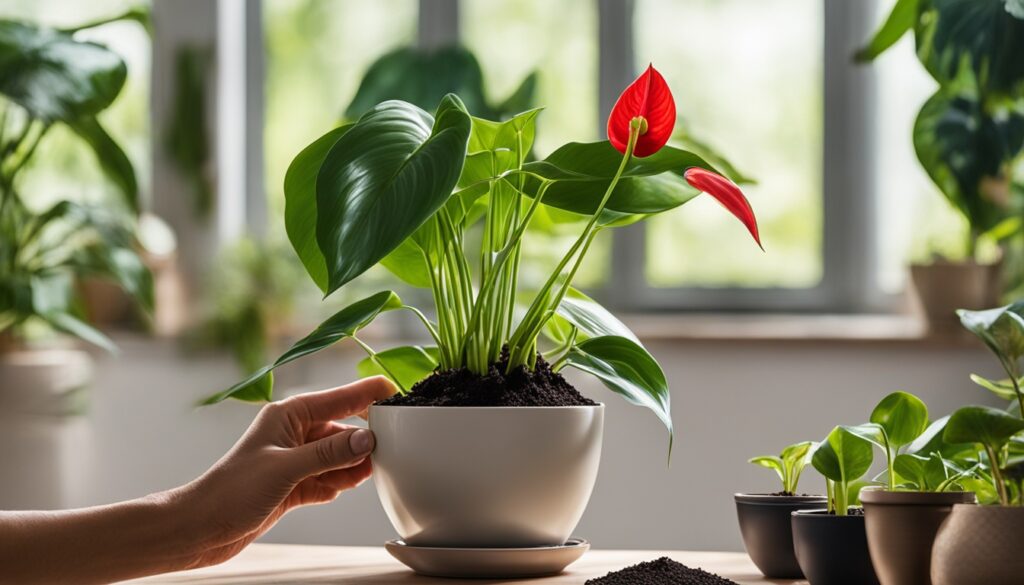Anthuriums are known for their bright and exotic flowers. They are a favorite for many indoor gardeners. Just like any other plant, they need care and a good home. This guide helps you re-pot your anthurium. It ensures it keeps growing and stays healthy.
Key Takeaways
- Repotting anthuriums promotes healthy growth and flowering.
- Look for signs like roots growing out of drainage holes or pot deformation.
- Spring is the ideal season for repotting guide anthuriums.
- Choose a well-draining potting mix and a slightly larger pot.
- Proper aftercare, including light, water, and humidity, is crucial.
Learn how to give your anthurium a new home. This will make it a striking part of your indoor space. By following our guide, you can ensure it thrives.
Introduction to Anthuriums
Anthuriums catch people’s eyes with their striking ornamental flowers. They’re also known as the “Flamingo Flower” or “Painter’s Palette.” These plants are popular for their vibrant colors. Anthuriums belong to the Araceae family and are originally from Central and South America’s rainforests.
What are Anthuriums?
Anthuriums stand out because of their distinct inflorescences. Each flower has a unique shape. It includes a modified leaf called a spathe and a central spadix where the flowers gather. The spathe comes in vivid colors from deep red to creamy white, making Anthuriums beautiful and unique.
Origins and Habitat
These plants come from the rainforests of Colombia and Ecuador. Anthuriums grow on trees and other surfaces. They do best in filtered light under the thick rainforest canopy. These plants need warm, humid environments and well-drained soil to thrive.
Ornamental Value
Anthuriums are more than just pretty. They last a long time indoors. With the right care, they can keep blooming for months. This adds a tropical feel to any room. They work well as a centerpiece or part of an indoor garden. Anthuriums bring charm with their vibrant colors.
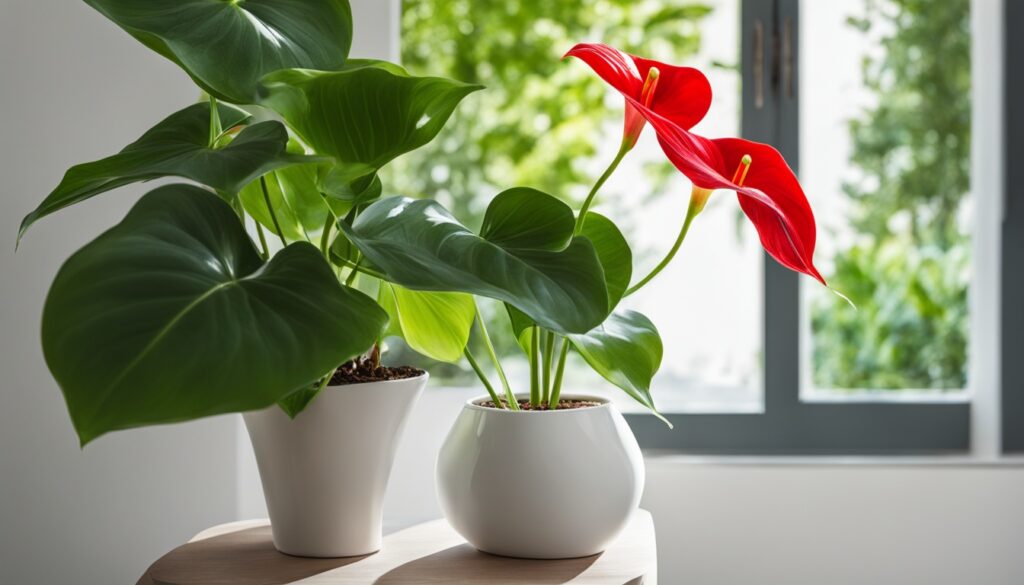
Why Repot Anthuriums?
Repotting your anthurium is key for growth and health. Mature tropical plants may need more room for their roots. They also need fresh soil and better drainage. Repotting benefits them a lot. It gives them room to grow, helps them stay healthy, and keeps their flowers looking great.
- Renewed Soil: The soil can lose its nutrients over time. Repotting helps by giving the plant new, rich soil. This makes the plant’s home a better place for it to grow.
- Root Expansion: The plant’s roots can get too tight in their small pots. A bigger pot with new soil lets the roots grow freely. This lets them get more water and nutrients, improving the plant’s health.
- Improved Drainage: Good drainage is a must to stop water from hurting the roots. By repotting, you put the plant in a pot that lets water out easily. This keeps the roots from getting too wet, helping the plant stay healthy.
If you don’t repot your anthurium, it might not grow well or look as good. Repotting every two years keeps them healthy. It makes sure they grow beautifully and live longer.
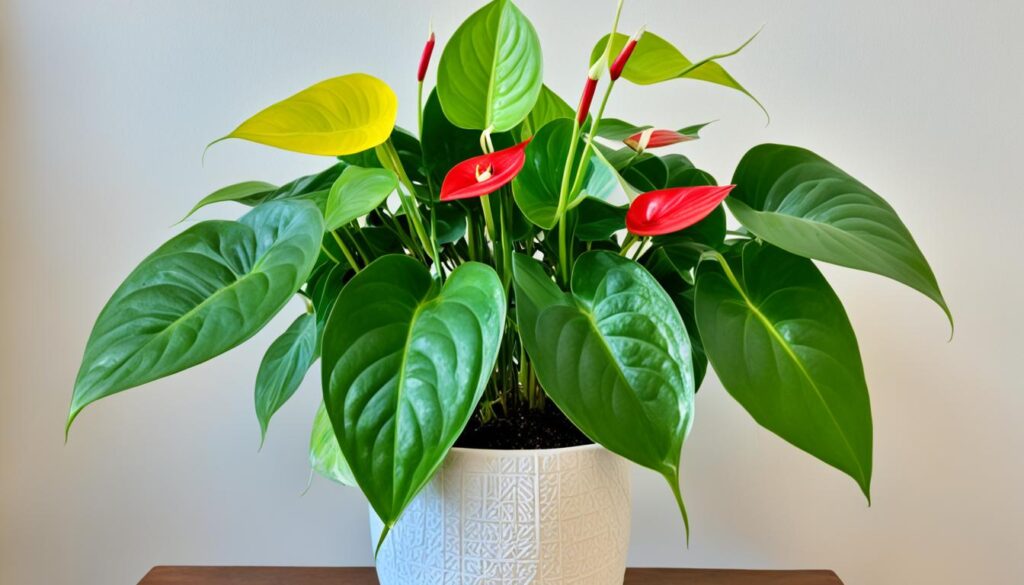
Signs Your Anthurium Needs Repotting
Anthuriums are known for their beautiful flowers and green leaves. But, they must be cared for properly. This includes repotting at the right times. Knowing when to do this will keep your plant healthy. Here are the signs to look for:
Roots Growing Out of Drainage Holes
Seeing roots peek out from the bottom of the pot is a clear repotting sign. It shows the plant’s roots are compacted. This makes it hard for the plant to get nutrients easily.
Leaf Spots and Discoloration
Yellow or brown spots on leaves mean your plant might be stressed. This can happen when roots have no room. Leaf discoloration might also mean your plant needs more nutrients and water.
Overly Elongated Stem
A stem growing too long is evidence of stunted growth. It’s the anthurium’s way of saying, “I need more space and light!”
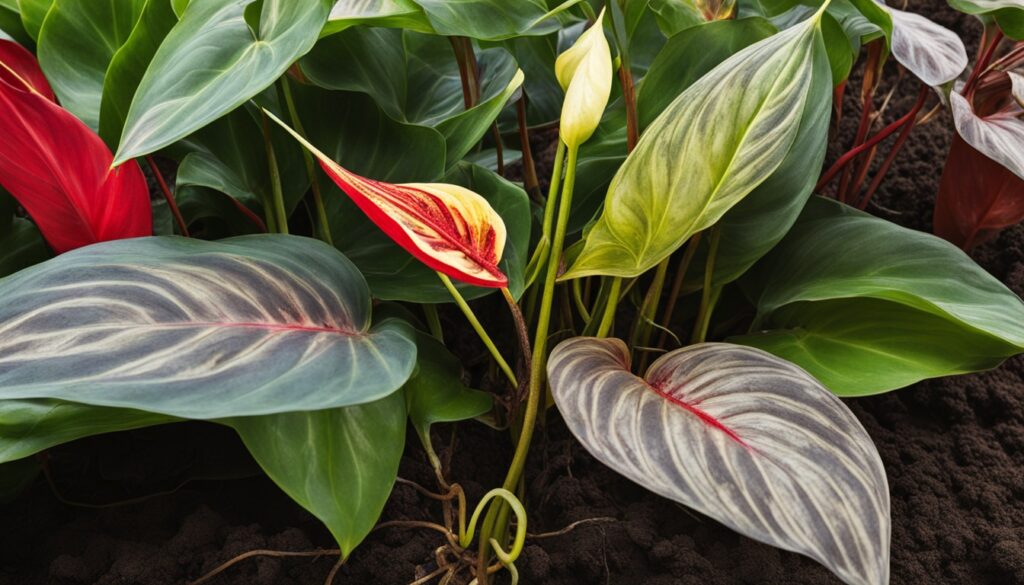
Smaller Leaf Size
New leaves much smaller than old ones can mean the anthurium lacks needed resources. Overcrowded roots can’t support the plant well.
Poor Flowering
A root-bound plant might not flower well. Giving it a bigger pot can mean more blooms. It gets the space and food it needs.
Pot Deformation
A pot that’s bulging or cracking is telling you the anthurium has outgrown it. This is a late sign. But fixing it can still help your plant.
Knowing these repotting signs allows you to care for your anthurium better. Repotting refreshes the soil, boosts root growth, and rejuvenates the plant. This way, it can keep showing off its beautiful flowers for many years.
When is the Best Time to Repot Anthuriums?
Choosing the right time to repot your anthurium directly affects its health. These tropical plants can handle different conditions. But, to ensure the best outcome, you should know the ideal times for repotting.
Avoiding Repotting After Purchase
After you’ve bought your anthurium, wait a bit before repotting. New plants need time to get used to their new home. The shock of repotting them too soon might be harmful. Let your anthurium settle in for a few weeks first.
Avoiding Repotting During Flowering
Since anthuriums are known for their beautiful flowers, it’s best not to repot during this time. Repotting can make them spend energy elsewhere, affecting their blooms. Wait until the plant has finished flowering to repot it.
Spring: The Ideal Season
Many people choose spring repotting for their anthurium. This is when the plant is waking up from winter. The warm weather and longer days help the plant start fresh. It can then grow strong roots and put energy into beautiful leaves and flowers.
In conclusion, early spring is the perfect time to repot your anthurium. Avoid repotting right after buying it or during flowering. Choosing the right time to repot helps your anthurium thrive and stay beautiful for years.
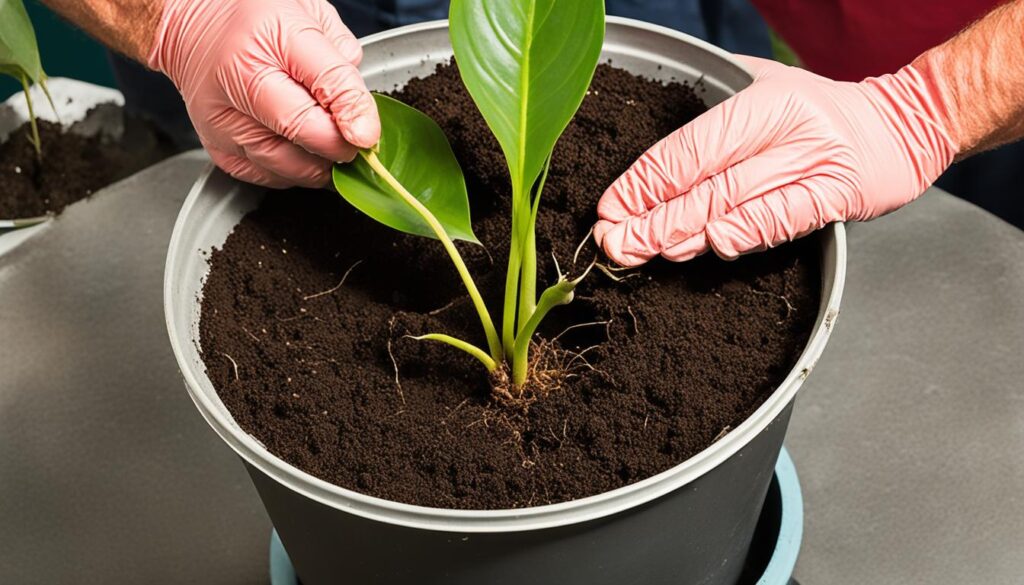
Preparing for Repotting
Before starting, make sure to have all you need. You’ll need the right size pot and the correct potting mix for your Anthurium.
Choosing the Right Pot Size
The pot’s size is very important for the Anthurium’s health. Choose a pot that’s a bit bigger than the one it’s in now. This lets the roots spread out properly.
Make sure the new pot has holes at the bottom. This helps water flow through and keeps the plant’s roots healthy.
Selecting a Suitable Potting Mix
The perfect potting mix for Anthuriums needs to drain well. Mixes that suit plants like orchids work great for them.
Look for mixes that have orchid bark, perlite, and peat moss. A touch of organic compost adds nutrients to the soil. This helps your plant grow strong.
Choose a mix that holds some water but drains well too. Anthuriums like slightly acidic soil. The pH should be between 5.5 and 6.5.
Watch out for soil that’s too wet. It can harm the roots and cause diseases.
- Plants should be repotted every 2-3 years to prevent the build-up of mineral salts from tap water over time.
- Over time, potting mix becomes compacted, affecting proper drainage and aeration for anthuriums.
- Clear plastic pots with ample drainage holes are recommended for repotting, allowing for easy root monitoring.
- Repotting can lead to an increase in new leaf size due to the plant’s ability to access fresh nutrients.
- Healthy roots are crucial for a plant’s overall health, with root-bound plants inviting pests and infections.
Picking the right pot and mix is key. It sets your Anthurium up to do well after repotting.
How to Repot Anthurium
Repotting your anthurium is crucial for its health. There are many types of anthuriums, with different colors. The repotting process is similar for them all. Anthuriums should be repotted every two to three years. This prevents root crowding and helps the plant get nutrients better.
Gently Removing the Plant
Begin by taking the anthurium out of its pot carefully. Loosen the soil around the edges so you don’t hurt the roots. Then, tilt the pot and pull the plant out. Support the base to keep the roots together.
Dividing or Propagating
When the plant is out, you can choose to divide or make new plants. Split the root ball into pieces. Make sure each piece has good roots and a growth point. This lets you grow more anthuriums from one plant.
Repotting Techniques
Get a new pot and put in fresh soil for anthuriums. Pick a pot that’s a bit bigger than the last. This gives the plant room to grow. Put the plant in the new pot’s center. Fill in around it with soil. Lightly press the soil to hold the plant in.
- Choose a pot with adequate drainage holes to prevent waterlogging.
- Consider using a pot with a water reservoir to maintain consistent moisture levels.
- Elevate the pot on a tray or saucer to catch any excess water.
Watering and Positioning
After repotting, give your anthurium a good watering. Place it where it gets bright, but not direct, sunlight. Anthuriums do best in filtered light. Avoid letting direct sun touch it for a while. Your plant needs three to seven days to get used to its new spot.
Caring for Your Repotted Anthurium
After you repot your anthurium, how you care for it is key. It’s important for its health and beauty. Let’s look at the vital things to remember:
Light Requirements
Anthuriums love filtered or indirect light. Don’t put them in direct sun, it can hurt their leaves. A window facing east or west is perfect. It gives them the light they need without harm.
Watering Needs
Keep the soil moist, but not soaking wet. Let the top layer of soil dry before watering again. Make sure when you water, some drains from the bottom of the pot.
Humidity Levels
Anthuriums enjoy high humidity, at 60% or more. There are easy ways to boost the moisture:
- Put a pebble tray filled with water under it
- Mist the leaves every so often
- Put it near other plants to make a little humid spot
Fertilizing Schedule
Feed your anthurium every 4-6 weeks in spring and summer. Use a balanced, water-soluble fertilizer. Mix it half strength with water. This gives the best nutrition to your plant.
Doing all these things right – the light, water, air, and food – will help your anthurium thrive. It will grow lush and give beautiful blooms.
Anthurium Varieties to Consider
Anthuriums are known for their stunning looks and unique leaves, making them a great choice for plant lovers. Out of all the anthurium varieties, the queen anthurium (Anthurium Warocqueanum) really shines. This rare plant has big, soft leaves and looks very regal. It’s a must-have for those who love plants.
Queen Anthurium (Anthurium Warocqueanum)
This plant comes from Colombia and is an amazing type of anthurium. It has big, deep green leaves that feel velvety. These features make the anthurium variety quite a standout, desirable for anyone who loves plants.
Where to Find Queen Anthuriums
Finding a queen anthurium can be hard because it’s rare. But, for those really keen, you can look in different places. Online shops, special plant nurseries, and shows might have some. Also, talking to fellow plant lovers or joining plant groups can help find one.
Care for Queen Anthuriums
Caring for this beauty can seem hard at first, but there are some simple steps to keep it happy:
- Light: It loves bright but not direct sunlight. Too much sun can harm its leaves.
- Water: Keep it moist but not soggy. Too much water will damage it.
- Humidity: Since it comes from the tropics, it loves high humidity. Consider a pebble tray or humidifier.
- Soil: It needs well-draining soil to mimic its natural home.
- Fertilizer: Use a balanced fertilizer, rich in phosphorus, once a month in the growing season.
Following these simple steps will help your queen anthurium thrive. With its beauty and elegance, it will surely make your home garden or plant collection stand out.
For more info on anthurium varieties and how to care for them, check out this link for a detailed guide on growing these beautiful plants.
Troubleshooting Common Issues
Even though anthuriums are beautiful, they can face problems we need to address quickly. These may include anthurium problems like pests and diseases, and even leaf discoloration. It’s crucial to spot and solve these issues to keep your anthuriums healthy and appealing.
- Overwatering is a leading problem, affecting about 60% of anthuriums. It causes root rot, shown by mushy and brown roots, and harms the stems.
- Nutrient deficiencies, especially a lack of nitrogen, are behind 40% of health problems. This often shows as slow growth or discolored leaves.
- Low humidity affects nearly 30% of anthuriums, reducing their growth and vigor. These plants need warm, humid surroundings like their tropical homes.
Facing issues like salt build-up from too much fertilizer (affecting almost 25% of plants) or pests such as aphids and spider mites (seen in 20% of plants) is tough on your anthurium’s health.
Not getting enough light affects about 35% of anthuriums, decreasing their chance to bloom. They love bright but indirect sunlight. No flowers might mean they’re not getting enough light, though too much direct sunlight can burn their leaves.
For some plants, it might just be that they’re still young, a factor in about 15% of cases. Thankfully, many owners (roughly 30%) turn to experts like those at Mavyn to get help with their anthurium issues.
Routine repotting every two to three years can keep your anthurium healthy. Use a container that drains well, filled with a mix of soil potting and orchid mix. This mixture helps prevent roots from getting too wet.
How to Repot Anthurium
Repotting keeps your anthurium healthy and growing strong. This repotting guide offers easy-to-follow steps. It also includes aftercare advice for your plant to do well in its new spot.
Step-by-Step Guide
Here’s how to repot your anthurium smoothly:
- Take the plant out of its old pot gently. Be careful not to harm the roots.
- Consider splitting the plant or taking off any new ones.
- Pick a new pot that’s bigger than the last with holes at the bottom for water to drain.
- Get a mix of peat moss, pine bark, and perlite for good drainage.
- Put the plant in the middle of the new pot. Fill around it with the mix.
- Water it well, so water comes out the bottom.
- Put pine bark on top to keep the moisture in and weeds out.
Repotting Techniques
Remember, repotting can stress the plant if you’re not careful. Try not to damage the roots. If the roots look bad or are growing out the bottom of the pot, it’s time to repot.
You should repot anthuriums every two to three years for new growth. Spring or summer is the best time. That’s when they grow the most.
Aftercare Tips
After you repot, your anthurium might need a little more care. Here are some tips for looking after it:
- Give it light, but not direct sun.
- Water it when the top soil is dry.
- Keep it humid with a mist or a tray of water.
- Feed it with a plant fertilizer every 4-6 weeks while it’s growing.
By using this repotting guide and step-by-step instructions, your anthurium will do great in its new pot. The key is to also provide good aftercare.
Conclusion
Repotting your anthurium is key to keeping it healthy and blooming. Follow our advice on choosing new homes, pots, and soil mix. This will bring your plant back to life with new growth and energy.
Remember, anthuriums do best when they get a new pot every 2-3 years. Use a slightly bigger pot each time. Springtime is perfect for repotting. This helps the plant settle into its new home without stress.
With the correct soil, humidity, and temperature, your anthurium will really bloom. Read back over our guide for more help to keep your anthurium thriving. Enjoy caring for your plant and watch it flourish.

